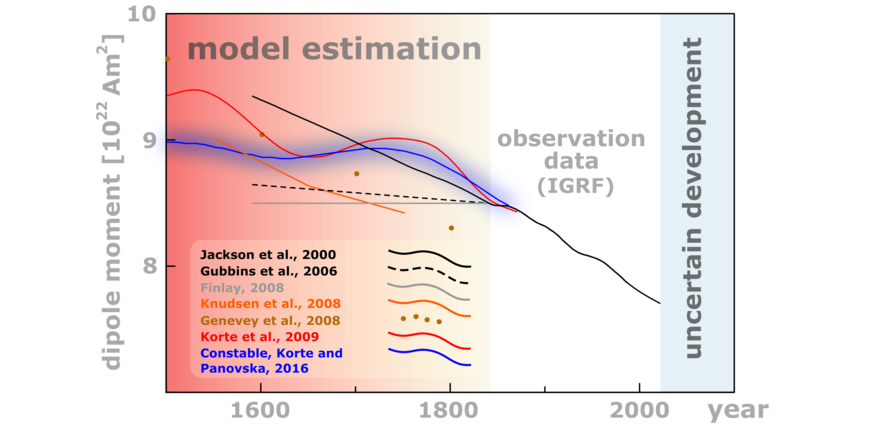Geogmagnetic field evolution
Our topic are long term variations of the geomagnetic core field on time scales from decades to millennia. Investigations of the long term evolution of the past magnetic field are used to make inferences about the dynamics of the outer core and the geodynamo processes that produce the field. They also provide estimates of the long term variation in the magnetospheric shielding against solar wind and galactic cosmic rays. Knowledge about past geomagnetic field variations and a better understanding of the underlying processes deep inside the Earth are necessary to estimate the future evolution of the geomagnetic field. Another application of our results lies in geomagnetic dating of archaeological material or lava flows and sediment cores, which are used, e.g., for environmental or climate studies. In particular, we reconstruct the extreme geomagnetic field changes during polarity reversals and excursions globally, in order to understand the underlying mechanisms.
Two categories of data form the important basis for our work: directly observed data and paleomagnetic data obtained in laboratory work.
Direct field observations
Geomagnetic observatories are providing observations of magnetic field intensity and directions since nearly 200 years. Worldwide magnetic observatory data are available from international programmes like INTERMAGNET and World Data Centers. We also use historical measurements of the geomagnetic field, which are available since about 500 years.
Paleomagnetic data
Information about strength and direction of the magnetic field prior to direct observation is obtained from lava flows, archaeological materials and sediment cores in laboratory experiments. Together with a suitable dating of the material this gives information about the evolution of the geomagnetic field of the past millennia and beyond. We collaborat with the paleomagnetic laboratory of section 5.2 and maintain a database (GEOMAGIA) with archeomagnetic, lava flow and paleomagnetic data of the past 50 000 years in a multinational collaboration.
We use the observations and measurements to determine global geomagnetic field models of the past millennia, which show the field variations for any location on Earth. We use similar mathematical methods for our long-term models as for the current core field modellling. The lower accuracy of the paleomagnetic data and their uneven global distribution together with dating uncertainties lead to notably lower spatial and temporal resolution of these models, which, however, represent large-scale variations and general temporal trends. The models can also represent the field distribution and evolution at the core-mantle boundary under the assumption that the low electrical conductivity of the mantle is negligible. They thus provide information about the dynamics of the Earth's core and the geodynamo process.
Geomagnetic Field Models
- CALSxk - a series of core field modes, spanning the past 3, 7 and 10 thousand years.
- LSMOD - Models for the time interval 50 - 30 ka, that contain the Laschamp and Mono Lake field excursions .



